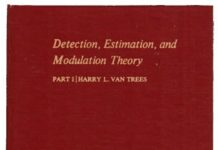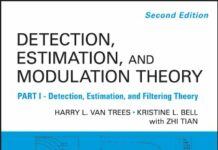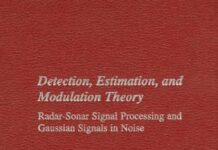
Ebook Info
- Published: 2002
- Number of pages: 1472 pages
- Format: PDF
- File Size: 20.05 MB
- Authors: Harry L. Van Trees
Description
Well-known authority, Dr. Van Trees updates array signal processing for today’s technologyThis is the most up-to-date and thorough treatment of the subject availableWritten in the same accessible style as Van Tree’s earlier classics, this completely new work covers all modern applications of array signal processing, from biomedicine to wireless communications
User’s Reviews
Editorial Reviews: Review “…an integrated presentation of classical and statistical array processing…develops synthesis techniques…” (SciTech Book News, Vol. 26, No. 2, June 2002) From the Inside Flap “Once again, Harry Van Trees has written the definitive textbook and research reference.” -Norman L. Owsley Office of Naval Research, IPA University of Rhode Island A comprehensive treatment of optimum array processing Array processing plays an important role in many diverse application areas, including radar, sonar, communications, seismology, radio astronomy, tomography, and cellular communications. Optimum Array Processing gives an integrated presentation of classical and statistical array processing. Classical analysis and synthesis techniques for linear and planar arrays are developed. A statistical characterization of space-time random processes is provided. Many different aspects of optimum array processing are covered, including waveform estimation, adaptive beamforming, parameter estimation, and signal detection. Both plane-wave signals and spatially spread signals are studied, and all results are developed in a pedagogically sound manner. This book provides a fundamental understanding of array processing that is ample preparation for research or implementation of actual array processing systems. It provides a comprehensive synthesis of the array processing literature and includes more than 2,000 references. Readers will find an extensive variety of models and criteria for study and comparison, realistic examples and practical applications of optimum algorithms, challenging problems that expand the book’s material, and detailed derivations of important results. A supplemental Web site is available that contains MATLAB(r) scripts for most of the figures used in the book so readers can explore diverse scenarios. The book uses results from Parts I and III of Detection, Estimation, and Modulation Theory. These two books have been reprinted in paperback for availability. For students in signal processing or professionals looking for thorough understanding of array processing theory, Optimum Array Processing provides authoritative, comprehensive coverage in the same clear manner as the earlier parts of Detection, Estimation, and Modulation Theory. From the Back Cover “Once again, Harry Van Trees has written the definitive textbook and research reference.” -Norman L. Owsley Office of Naval Research, IPA University of Rhode Island A comprehensive treatment of optimum array processing Array processing plays an important role in many diverse application areas, including radar, sonar, communications, seismology, radio astronomy, tomography, and cellular communications. Optimum Array Processing gives an integrated presentation of classical and statistical array processing. Classical analysis and synthesis techniques for linear and planar arrays are developed. A statistical characterization of space-time random processes is provided. Many different aspects of optimum array processing are covered, including waveform estimation, adaptive beamforming, parameter estimation, and signal detection. Both plane-wave signals and spatially spread signals are studied, and all results are developed in a pedagogically sound manner. This book provides a fundamental understanding of array processing that is ample preparation for research or implementation of actual array processing systems. It provides a comprehensive synthesis of the array processing literature and includes more than 2,000 references. Readers will find an extensive variety of models and criteria for study and comparison, realistic examples and practical applications of optimum algorithms, challenging problems that expand the book’s material, and detailed derivations of important results. A supplemental Web site is available that contains MATLAB(r) scripts for most of the figures used in the book so readers can explore diverse scenarios. The book uses results from Parts I and III of Detection, Estimation, and Modulation Theory. These two books have been reprinted in paperback for availability. For students in signal processing or professionals looking for thorough understanding of array processing theory, Optimum Array Processing provides authoritative, comprehensive coverage in the same clear manner as the earlier parts of Detection, Estimation, and Modulation Theory. About the Author HARRY L. VAN TREES, ScD, is Distinguished Professor of Electrical Engineering and Director of the C3I Center of Excellence at George Mason University, Fairfax, Virginia. During his career, he was professor of electrical engineering at Massachusetts Institute of Technology, and served as Chief Scientist of the U.S. Air Force, Chief Scientist of the Defense Communications Agency, and Principal Deputy Assistant Secretary of Defense for C3I. He was also president of M/A-Com-Linkabit Government Systems and a cofounder of CommQuest Technologies. Read more
Reviews from Amazon users which were colected at the time this book was published on the website:
⭐Love this book! I’m biased as I took this class with Dr. Van Trees, but it is a very detailed book on array processing. Because this book has been around for a while I would consider it a book on classical techniques. For a book that goes into more modern direction finding algorithms, I would recommend Classical and Modern Direction-of-Arrival by Tuncer and Friedlander.
⭐This book is all about equation. Mr Trees goes through great details to derive the equations but misses the theory completely. I would not recommend this book for starters who want to understand the concept.
⭐I have a unique perspective on this book because I was a student in Dr VanTree’s classes at George Mason prior to the book’s official publication. I’m biased and consider myself privileged to be so. Having taken classes from other notable researchers in the subject over the years, the essential feature of this book is that it starts at the BEGINNING. One is grounded in classical shading techniques prior to moving on to optimal and then adaptive techniques. One develops a habit of plotting the pattern and looking at the white noise gain. The strength of the book is the way the material is organized. This book is intended to provide the grounding necessary to move onto more advanced topics. It is not the latest results. There are many more current topics such as blind estimation and MIMO that are not treated here. No single book will ever completely cover this topic. It is good to keep a copy of Dudgeon and Johnson nearby when reading this book. One of the unique aspects of this book is the problem sets. Many of the problems do not have a straightforward unique solution. This is intentional because this is what an engineer will encounter in their career. I recall asking a question in class and Van Trees responding “That’s a good question, I need to write that down” and then unfazzed, he continued on with the lecture. This makes the book challenging. If you are a teacher, you need to work out the problems before you assign them.IMHO, array processing is a very large field and there are many who know a great deal about very little. This book provides a base of knowledge that other books and particularly the literature assume the reader already knows. This book makes the topic much more approachable. It’s not an easy book. It’s not an easy topic.
⭐It was a great pleasure for me to discover this book after having tried to read several other books on the subject. The explanations and mathematics are crystal clear and anyone but the most indolent should have a great pleasure in the detail and effort put behind this book. As one example, I have looked for an explanation of the theory behind Dolph-Chebychev windows. This was clearly and simple described, so the reader has a chance to understand (and remember!) the material, instead of just jotting down many equations of various unknown origin. A great many array geometries, methods and techniques are considered and explained in detail. All in all, a lot of information I only wish, I had available several years ago.For the serious reader I have found no comparable book on the subject.For the beginnner, “adaptive signal processing” by Widrow may be more appropriate.
⭐Van Trees previously published book on detection and estimation was a sort of bible for graduate level textbook in the 70s and 80s. This book is a lengthy re-statement of known results published widely in many text books. I did not find a single chapter or section with any new insight. I also contacted the author to get a copy of his Matlab simulations (not available on the web site noted in the book) and after repeated e-mails, I never received a response. The partial Matlab code downloaded from the site is incomplete and poorly organized.Overall, I do not recommend this book to anyone interested in this topic.
⭐I cannot imagine that this book has been written by Van Trees. I was a fan of him after studying his 1st and third volumes during my MSc, but taking a course on Array Signal Proc. and Adaptive Array Sig. Proc. in the next one, i was ehgulfed in mathematics and only mathematics, with no intuitional background at all. The author only has given mathematics, not have grip on the theoretical concepts or may be he has failed to convey them. I will never tell anybody about this book for this course, its for sure. Engr. Hasan Noor Khan. M.Sc. Electronics & Communication Engg. B.Sc. Electrical Engg.
Keywords
Free Download Optimum Array Processing: Part IV of Detection, Estimation, and Modulation Theory 1st Edition in PDF format
Optimum Array Processing: Part IV of Detection, Estimation, and Modulation Theory 1st Edition PDF Free Download
Download Optimum Array Processing: Part IV of Detection, Estimation, and Modulation Theory 1st Edition 2002 PDF Free
Optimum Array Processing: Part IV of Detection, Estimation, and Modulation Theory 1st Edition 2002 PDF Free Download
Download Optimum Array Processing: Part IV of Detection, Estimation, and Modulation Theory 1st Edition PDF
Free Download Ebook Optimum Array Processing: Part IV of Detection, Estimation, and Modulation Theory 1st Edition


